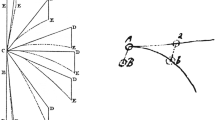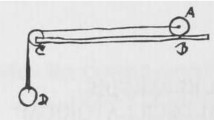Abstract
Maurice Clavelin has offered a brilliant reconstruction of the conceptual and technical aspect of Galileo’s geometrical analysis of the motion of freely falling bodies. He has captured the gist of Galileo’s method, and he has shown with remarkable clarity (I am tempted to say with typical French clarity) the importance of Book V of Euclid’s Elements, which deals with the theory of proportions, on Galileo’s interpretation of motion both in his earlier works and in his mature masterpiece, the Discourses on Two New Sciences. Clavelin underlines the significance of the change that was introduced by thinking of motion not as a process, as the Aristotelians did, but as a state, as has become familiar to students of physics since the seventeenth century. He rightly emphasizes the gradual discovery of the law of inertia and he shows how the ambiguities of the early formulations should not blind us to the suggestiveness they acquired for the generation immediately following Galileo. Clavelin also reminds us of some of the limitations of traditional geometry, for instance, that metrical formulae involving the ratios of unlike quantities were not entertained. This explains why we never find our general expression v = s/t in Galileo for whom v, like s and t,is a basic and non-reducible magnitude. Finally, Clavelin distinguishes between the momento del descendere and the momentum velocitatis in his attempt to capture the gravitational and the motive role of weight. I shall have to qualify some of Clavelin’s asser- tions about the relation between the dual function of weight, but let me say at the outset that I owe much to Clavelin who was the first historian of science, to my knowledge, to draw attention to the crucial role that the notion of momento plays at the junction between Galileo’s kinematics and his dynamics.1
Access this chapter
Tax calculation will be finalised at checkout
Purchases are for personal use only
Preview
Unable to display preview. Download preview PDF.
Similar content being viewed by others
Notes
Maurice Ciavelin, La philosophie naturelle de Galileo, Armand Colin, Paris, 1968.
Letter to Mersenne, 11 October 1638, in René Descartes, Oeuvres, Charles Adam and Paul Tannery (ed.), 12 vols, and index, 1897-1913, Vol. II, p. 380.
Galileo Galilei, Opere A. Favaro (ed.), 20 vols. Barbèra, Florence, 1890-1909, Vol. I. De Motu is partly translated with introduction and notes by J. E. Drabkin in Galileo Galilei, On Motion and On Mechanics. University of Wisconsin Press, Madison, 1960.
Galileo, Opere, Vol. VIII, p. 118.
Ibid., Vol. VII, p. 731 and pp. 742-743.
Galilean mss., Biblioteca Nazionale, Florence, Vol. 72, F. 179 v, reproduced in Opere, Vol. VIII, p. 389.
Galileo, Opere, Vol. VIII, p. 218.
Giovanbattista Baliani, De motu gravium, Genoa, 1646, quoted in Raffaello Caverni, Storia del metodo sperimentale in Italia, 6 vols. Florence: Stabilimento G. Civelli, 1891-1900. Reprint, Johnson Reprint Corporation, New York, 1972, Vol. IV, p. 278.
Evangelista Torricelli to Marin Mersenne, 15 January 1645 in Opere dei Discepoli di Galileo Carteggio, Vol. I (1642-1648), P. Galluzzi and M. Torrini (eds.), Giunti Barbera, Florence, 1975, p. 182.
Galileo, Opere, Vol. VIII, pp. 441–442. The most recent discussion of the problem of acceleration is Paolo Galluzzi’s remarkable Momento Studi Galileiani. Edizioni dell’Ateneo e Bizzarri, Roma, 1979.
Ibid., p. 209.
Ibid., p. 198.
Ibid., p. 243.
Galluzzi, Momento, pp. 370–371.
Author information
Authors and Affiliations
Editor information
Editors and Affiliations
Rights and permissions
Copyright information
© 1983 D. Reidel Publishing Company, Dordrecht, Holland
About this chapter
Cite this chapter
Shea, W.R. (1983). The Galilean Geometrization of Motion: Some Historical Considerations. In: Shea, W.R. (eds) Nature Mathematized. The University of Western Ontario Series in Philosophy of Science, vol 20. Springer, Dordrecht. https://doi.org/10.1007/978-94-009-6957-5_3
Download citation
DOI: https://doi.org/10.1007/978-94-009-6957-5_3
Publisher Name: Springer, Dordrecht
Print ISBN: 978-94-009-6959-9
Online ISBN: 978-94-009-6957-5
eBook Packages: Springer Book Archive




